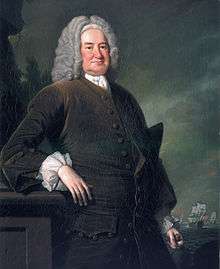George Knapton

George Knapton (1698–1778) was an English portrait painter and the first portraitist for the Society of Dilettanti in the 1740s. He became Surveyor and Keeper of the King's Pictures from 1765–78.[2]
Life and work
Knapton was born in Christchurch, Hampshire, the son of William Knapton Esquire of Brockenhurst, Hampshire. He studied art under Jonathan Richardson, then at the St. Martin's Lane Academy. He spent some years in Italy where he became known as a sound judge of the works of the Old Masters. An account of his visit to Herculaneum was published in the "Philosophical Transactions" of 1740 (no. 458).[2]
Knapton was an original member of the "Society of Dilettanti" and their first portrait artist. He painted many members of the society – mostly in fancy dress – including the Duke of Dorset, Viscount Galway, Sir Francis Dashwood, the Earl of Holdernesse, Earl of Bessborough and Sir Bourchier Wray.[3] Knapton resigned his position at the society in 1763.[2]
In 1750, the then Prince of Wales commissioned Knapton, together with George Vertue, to produce a catalogue of the pictures at Kensington Palace, Hampton Court and Windsor castle. In 1765, he succeeded Stephen Slaughter as Surveyor and Keeper of the King's Pictures; he was also in charge of Lord Spencer's collection at Althorp, Northamptonshire.[2]

Knapton's largest painting was that of the widowed Princess of Wales and her family (1751).[4] He also painted portraits of the Earl of Upper Ossory (with his brother and sister), the Earl of Burlington, Admiral Sir John Norris, Francis, Fifth Duke of Leeds, Admiral George Vandeput, Archibald Bower, Nicolas Tindal, Hildebrand Jacob, Admiral Edward Hawke,[5] and the singers Carestini and Lisabetta du Parc.[2][6]
Knapton assisted his brother James, a book publisher in London in the production of several publications including works by Thomas Birch and The History of England by Nicolas Tindal and Paul de Rapin.[2] James was born in 1701 in Christchurch, Hampshire. John and Paul Knapton succeeded to and extended their father's business.
Knapton died in Kensington in December 1778 and was buried there on the 28th of that same month.[2]
Knapton's brother, Charles Knapton, born in Christchurch, Hampshire (1700–1760), was also an artist and, together with Arthur Pond (1705?–1758), published a book Imitations of the Italian Masters (1735), which contained many engravings by himself, mainly of works by Guercino.[2]
Sources
- ↑ "BHC2912, Admiral Sir John Norris, circa 1660–1749". Collections Online. National Maritime Museum. Retrieved 28 November 2010.
- 1 2 3 4 5 6 7 8 "Knapton, George". Dictionary of National Biography. London: Smith, Elder & Co. 1885–1900.
- ↑ Bourchier Wray by George Knapton
- ↑ The Family of Frederick, Prince of Wales (Royal Collection).
- ↑ Sir Edwin Hawke (Falmouth Art Gallery).
- ↑ Lisabetta du Parc (National Portrait Gallery).
Further reading
- Redford, Bruce. Dilettanti: the antic and the antique in eighteenth-century England (Los Angeles: J. Paul Getty Museum, 2008).
External links
| Wikimedia Commons has media related to George Knapton. |
- George Knapton online (Artcyclopedo)
- George Knapton ("Draw Paint Sculpt")